Nan Liu
Enabling Inclusive Systematic Reviews: Incorporating Preprint Articles with Large Language Model-Driven Evaluations
Mar 19, 2025Abstract:Background. Systematic reviews in comparative effectiveness research require timely evidence synthesis. Preprints accelerate knowledge dissemination but vary in quality, posing challenges for systematic reviews. Methods. We propose AutoConfidence (automated confidence assessment), an advanced framework for predicting preprint publication, which reduces reliance on manual curation and expands the range of predictors, including three key advancements: (1) automated data extraction using natural language processing techniques, (2) semantic embeddings of titles and abstracts, and (3) large language model (LLM)-driven evaluation scores. Additionally, we employed two prediction models: a random forest classifier for binary outcome and a survival cure model that predicts both binary outcome and publication risk over time. Results. The random forest classifier achieved AUROC 0.692 with LLM-driven scores, improving to 0.733 with semantic embeddings and 0.747 with article usage metrics. The survival cure model reached AUROC 0.716 with LLM-driven scores, improving to 0.731 with semantic embeddings. For publication risk prediction, it achieved a concordance index of 0.658, increasing to 0.667 with semantic embeddings. Conclusion. Our study advances the framework for preprint publication prediction through automated data extraction and multiple feature integration. By combining semantic embeddings with LLM-driven evaluations, AutoConfidence enhances predictive performance while reducing manual annotation burden. The framework has the potential to facilitate systematic incorporation of preprint articles in evidence-based medicine, supporting researchers in more effective evaluation and utilization of preprint resources.
MMLU-ProX: A Multilingual Benchmark for Advanced Large Language Model Evaluation
Mar 13, 2025Abstract:Traditional benchmarks struggle to evaluate increasingly sophisticated language models in multilingual and culturally diverse contexts. To address this gap, we introduce MMLU-ProX, a comprehensive multilingual benchmark covering 13 typologically diverse languages with approximately 11,829 questions per language. Building on the challenging reasoning-focused design of MMLU-Pro, our framework employs a semi-automatic translation process: translations generated by state-of-the-art large language models (LLMs) are rigorously evaluated by expert annotators to ensure conceptual accuracy, terminological consistency, and cultural relevance. We comprehensively evaluate 25 state-of-the-art LLMs using 5-shot chain-of-thought (CoT) and zero-shot prompting strategies, analyzing their performance across linguistic and cultural boundaries. Our experiments reveal consistent performance degradation from high-resource languages to lower-resource ones, with the best models achieving over 70% accuracy on English but dropping to around 40% for languages like Swahili, highlighting persistent gaps in multilingual capabilities despite recent advances. MMLU-ProX is an ongoing project; we are expanding our benchmark by incorporating additional languages and evaluating more language models to provide a more comprehensive assessment of multilingual capabilities.
Real-world Deployment and Evaluation of PErioperative AI CHatbot (PEACH) -- a Large Language Model Chatbot for Perioperative Medicine
Dec 24, 2024



Abstract:Large Language Models (LLMs) are emerging as powerful tools in healthcare, particularly for complex, domain-specific tasks. This study describes the development and evaluation of the PErioperative AI CHatbot (PEACH), a secure LLM-based system integrated with local perioperative guidelines to support preoperative clinical decision-making. PEACH was embedded with 35 institutional perioperative protocols in the secure Claude 3.5 Sonet LLM framework within Pair Chat (developed by Singapore Government) and tested in a silent deployment with real-world data. Accuracy, safety, and usability were assessed. Deviations and hallucinations were categorized based on potential harm, and user feedback was evaluated using the Technology Acceptance Model (TAM). Updates were made after the initial silent deployment to amend one protocol. In 240 real-world clinical iterations, PEACH achieved a first-generation accuracy of 97.5% (78/80) and an overall accuracy of 96.7% (232/240) across three iterations. The updated PEACH demonstrated improved accuracy of 97.9% (235/240), with a statistically significant difference from the null hypothesis of 95% accuracy (p = 0.018, 95% CI: 0.952-0.991). Minimal hallucinations and deviations were observed (both 1/240 and 2/240, respectively). Clinicians reported that PEACH expedited decisions in 95% of cases, and inter-rater reliability ranged from kappa 0.772-0.893 within PEACH and 0.610-0.784 among attendings. PEACH is an accurate, adaptable tool that enhances consistency and efficiency in perioperative decision-making. Future research should explore its scalability across specialties and its impact on clinical outcomes.
Fashion-VDM: Video Diffusion Model for Virtual Try-On
Nov 04, 2024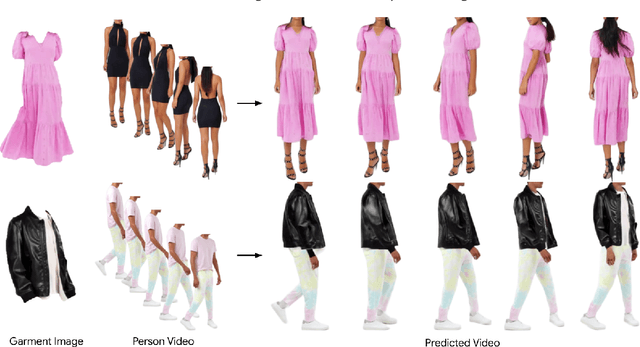
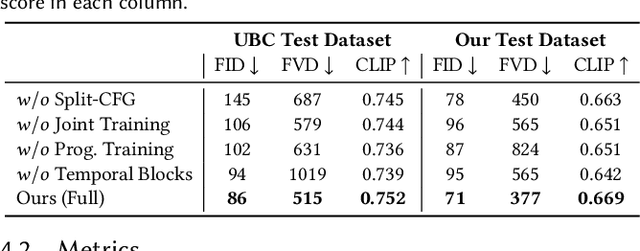
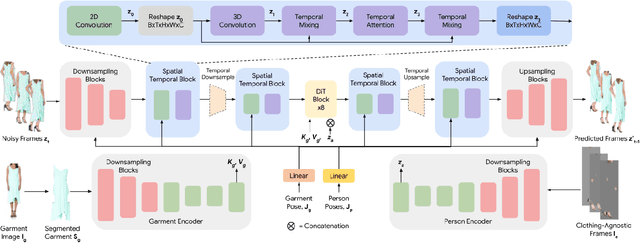
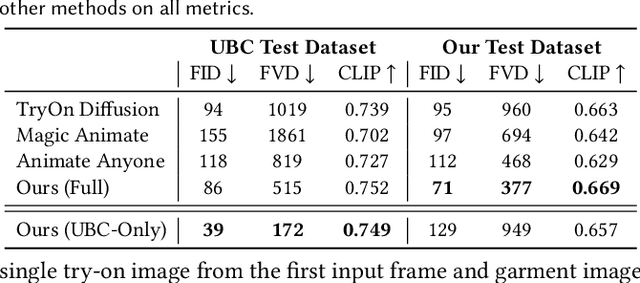
Abstract:We present Fashion-VDM, a video diffusion model (VDM) for generating virtual try-on videos. Given an input garment image and person video, our method aims to generate a high-quality try-on video of the person wearing the given garment, while preserving the person's identity and motion. Image-based virtual try-on has shown impressive results; however, existing video virtual try-on (VVT) methods are still lacking garment details and temporal consistency. To address these issues, we propose a diffusion-based architecture for video virtual try-on, split classifier-free guidance for increased control over the conditioning inputs, and a progressive temporal training strategy for single-pass 64-frame, 512px video generation. We also demonstrate the effectiveness of joint image-video training for video try-on, especially when video data is limited. Our qualitative and quantitative experiments show that our approach sets the new state-of-the-art for video virtual try-on. For additional results, visit our project page: https://johannakarras.github.io/Fashion-VDM.
oRetrieval Augmented Generation for 10 Large Language Models and its Generalizability in Assessing Medical Fitness
Oct 11, 2024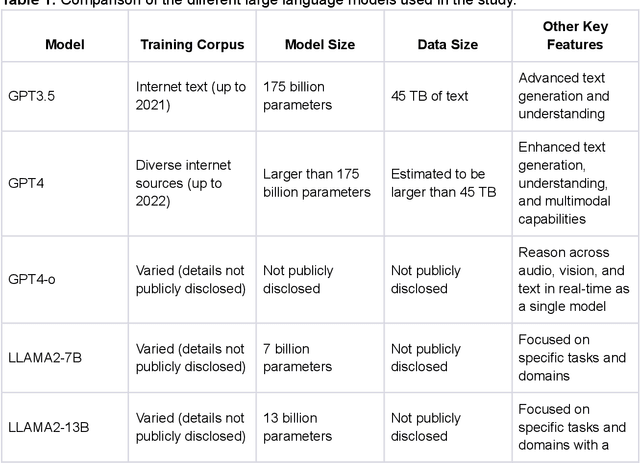



Abstract:Large Language Models (LLMs) show potential for medical applications but often lack specialized clinical knowledge. Retrieval Augmented Generation (RAG) allows customization with domain-specific information, making it suitable for healthcare. This study evaluates the accuracy, consistency, and safety of RAG models in determining fitness for surgery and providing preoperative instructions. We developed LLM-RAG models using 35 local and 23 international preoperative guidelines and tested them against human-generated responses. A total of 3,682 responses were evaluated. Clinical documents were processed using Llamaindex, and 10 LLMs, including GPT3.5, GPT4, and Claude-3, were assessed. Fourteen clinical scenarios were analyzed, focusing on seven aspects of preoperative instructions. Established guidelines and expert judgment were used to determine correct responses, with human-generated answers serving as comparisons. The LLM-RAG models generated responses within 20 seconds, significantly faster than clinicians (10 minutes). The GPT4 LLM-RAG model achieved the highest accuracy (96.4% vs. 86.6%, p=0.016), with no hallucinations and producing correct instructions comparable to clinicians. Results were consistent across both local and international guidelines. This study demonstrates the potential of LLM-RAG models for preoperative healthcare tasks, highlighting their efficiency, scalability, and reliability.
Estimation and Inference for Causal Functions with Multiway Clustered Data
Sep 10, 2024Abstract:This paper proposes methods of estimation and uniform inference for a general class of causal functions, such as the conditional average treatment effects and the continuous treatment effects, under multiway clustering. The causal function is identified as a conditional expectation of an adjusted (Neyman-orthogonal) signal that depends on high-dimensional nuisance parameters. We propose a two-step procedure where the first step uses machine learning to estimate the high-dimensional nuisance parameters. The second step projects the estimated Neyman-orthogonal signal onto a dictionary of basis functions whose dimension grows with the sample size. For this two-step procedure, we propose both the full-sample and the multiway cross-fitting estimation approaches. A functional limit theory is derived for these estimators. To construct the uniform confidence bands, we develop a novel resampling procedure, called the multiway cluster-robust sieve score bootstrap, that extends the sieve score bootstrap (Chen and Christensen, 2018) to the novel setting with multiway clustering. Extensive numerical simulations showcase that our methods achieve desirable finite-sample behaviors. We apply the proposed methods to analyze the causal relationship between mistrust levels in Africa and the historical slave trade. Our analysis rejects the null hypothesis of uniformly zero effects and reveals heterogeneous treatment effects, with significant impacts at higher levels of trade volumes.
A Proposed S.C.O.R.E. Evaluation Framework for Large Language Models : Safety, Consensus, Objectivity, Reproducibility and Explainability
Jul 10, 2024



Abstract:A comprehensive qualitative evaluation framework for large language models (LLM) in healthcare that expands beyond traditional accuracy and quantitative metrics needed. We propose 5 key aspects for evaluation of LLMs: Safety, Consensus, Objectivity, Reproducibility and Explainability (S.C.O.R.E.). We suggest that S.C.O.R.E. may form the basis for an evaluation framework for future LLM-based models that are safe, reliable, trustworthy, and ethical for healthcare and clinical applications.
Compositional Image Decomposition with Diffusion Models
Jun 27, 2024Abstract:Given an image of a natural scene, we are able to quickly decompose it into a set of components such as objects, lighting, shadows, and foreground. We can then envision a scene where we combine certain components with those from other images, for instance a set of objects from our bedroom and animals from a zoo under the lighting conditions of a forest, even if we have never encountered such a scene before. In this paper, we present a method to decompose an image into such compositional components. Our approach, Decomp Diffusion, is an unsupervised method which, when given a single image, infers a set of different components in the image, each represented by a diffusion model. We demonstrate how components can capture different factors of the scene, ranging from global scene descriptors like shadows or facial expression to local scene descriptors like constituent objects. We further illustrate how inferred factors can be flexibly composed, even with factors inferred from other models, to generate a variety of scenes sharply different than those seen in training time. Website and code at https://energy-based-model.github.io/decomp-diffusion.
Retrieval-Augmented Generation for Generative Artificial Intelligence in Medicine
Jun 18, 2024Abstract:Generative artificial intelligence (AI) has brought revolutionary innovations in various fields, including medicine. However, it also exhibits limitations. In response, retrieval-augmented generation (RAG) provides a potential solution, enabling models to generate more accurate contents by leveraging the retrieval of external knowledge. With the rapid advancement of generative AI, RAG can pave the way for connecting this transformative technology with medical applications and is expected to bring innovations in equity, reliability, and personalization to health care.
M&M VTO: Multi-Garment Virtual Try-On and Editing
Jun 06, 2024



Abstract:We present M&M VTO, a mix and match virtual try-on method that takes as input multiple garment images, text description for garment layout and an image of a person. An example input includes: an image of a shirt, an image of a pair of pants, "rolled sleeves, shirt tucked in", and an image of a person. The output is a visualization of how those garments (in the desired layout) would look like on the given person. Key contributions of our method are: 1) a single stage diffusion based model, with no super resolution cascading, that allows to mix and match multiple garments at 1024x512 resolution preserving and warping intricate garment details, 2) architecture design (VTO UNet Diffusion Transformer) to disentangle denoising from person specific features, allowing for a highly effective finetuning strategy for identity preservation (6MB model per individual vs 4GB achieved with, e.g., dreambooth finetuning); solving a common identity loss problem in current virtual try-on methods, 3) layout control for multiple garments via text inputs specifically finetuned over PaLI-3 for virtual try-on task. Experimental results indicate that M&M VTO achieves state-of-the-art performance both qualitatively and quantitatively, as well as opens up new opportunities for virtual try-on via language-guided and multi-garment try-on.
 Add to Chrome
Add to Chrome Add to Firefox
Add to Firefox Add to Edge
Add to Edge